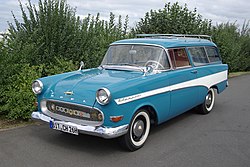
The Ford Taunus is a family car that was sold by Ford Germany throughout Europe. Models from 1970 onward were built on the same basic construction as the Ford Cortina MkIII in the United Kingdom, and later on, the two car models were essentially the same, differing almost only in the placement of the steering wheel. The model line was named after the Taunus mountain range in Germany, and was first made in 1939, and continued through several versions until 1994.

The Opel Ascona is a large family car that was produced by the German automaker Opel from 1970 to 1988. It was produced in three separate generations, beginning with rear-wheel-drive and ending up as a front-wheel drive J-car derivative.

The Opel Rekord is a large family car which was built in eight generations by the German car manufacturer Opel. Between 1953 and 1986, approximately ten million were sold.

The Ford Sidevalve is a side valve from the British arm of the Ford Motor Company, often also referred to as the "English Sidevalve". The engine had its origins in the 1930s Ford Model Y, and was made in two sizes, 933 cc (56.9 cu in) or "8 HP", and 1,172 cc (71.5 cu in) or "10 HP". The early engines did not have a water pump as standard, instead relying on thermosiphon cooling as the Model T engine had. A water pump was added in 1953 for the 100E models when the engine was re-engineered to the point that few specifications are identical between the early and the later series. The Sidevalve engine was used in many smaller Fords as well as farm vehicles, commercial vehicles and a marine version in boats. Production of the engine was stopped in 1962. Windscreen wipers were often driven by the vacuum generated in the inlet manifold.

The Opel Olympia is a compact car by German automaker Opel, then part of G.M., from 1935 to 1940, and after World War II continued from 1947 to 1953. It was one of the world's first mass-produced cars with a unitary body structure, after the 1934 Citroën Traction Avant; and it was a mass-production success, made in six-figure numbers. Opel achieved this even before the war, all while Hitler promised Germany a "Volkswagen" - a 'People's car', which didn't materialize until 1946. From 1967-1970 the Olympia badge was briefly reused on a later car.
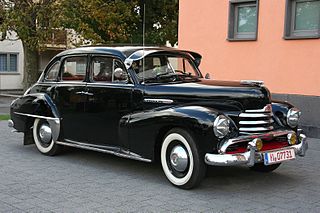
The Opel Kapitän is a luxury car made in several different generations by the German car manufacturer Opel from 1938 until 1970.

The Opel Super 6 is an executive car which was built by the German car manufacturer Opel between 1937 and late 1938. The car was equipped with a 2.5-litre straight-six engine and had a top speed of 115 km/h (71 mph). It was available in three different versions: a 4-door sedan, a 2-door coupé, and a 2-door cabriolet. A small number of custom-bodied cars were also made by various coachbuilders such as Karosseriewerke Otto Kühn and Gläser.

The Opel Olympia Rekord is a two-door Executive car that replaced the Opel Olympia in March 1953. The car was marketed through 1957.

The Ford Taunus G93A is a small family car that was produced by Ford Germany between 1939 and 1942 in succession to the Ford Eifel. It was the first car developed at Cologne by Ford Germany which previously had built cars originated by Ford businesses in the US or the UK. Production began on 30 April 1939, with the first car exhibited to the public in June 1939, less than six months before the outbreak of war in Europe.

The Ford Taunus P1 is a small family car which was produced by Ford Germany from 1952 until 1962. It was marketed as the Ford Taunus 12M, and, between 1955 and 1959, as the larger-engined Ford Taunus 15M. The company produced a succession of Ford Taunus 12M models until 1970, as the name was applied to a succession of similarly sized cars, but the first Taunus 12M models, based on the company's Taunus Project 1 (P1), remained in production only until 1962. In that year the Taunus P1 series was replaced by the Taunus P4 series.
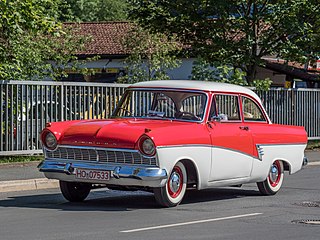
The Ford Taunus 17 M is a middle sized family saloon/sedan that was produced by Ford Germany between August 1957 and August 1960. The Taunus 17M name was also applied to subsequent Ford models which is why the car is usually identified, in retrospect, as the Ford Taunus P2. It was the second newly designed German Ford to be launched after the war and for this reason it was from inception known within the company as Ford Project 2 (P2) or the Ford Taunus P2.
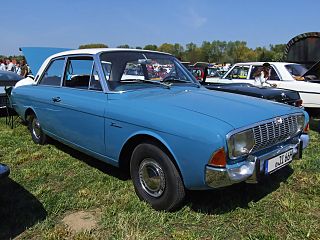
The Ford Taunus 17 M is a middle-weight family saloon/sedan that was produced by Ford Germany between 1964 and 1967. The entire range was first presented in September 1964 and volume production of the two and four door saloons/sedans began in November 1964. The "Turnier" version followed in January 1965 with coupé bodied cars coming along some time later.

The Ford P7 is a range of large family saloons/sedans produced by Ford Germany between autumn 1967 and December 1971. The P7 was marketed as the Ford 17M, Ford 20M and Ford 26M.

The Opel Rekord P2 is a Executive car that was introduced in the summer of 1960, by Opel as a replacement for the Opel Rekord P1. It shared its 2,541 mm wheelbase with its predecessor, but was nonetheless a little longer and wider. The wrap-around windscreen which had been a defining element of the Rekord P1, and which had given rise to the P for "Panorama" designation, was now gone, but the P designation remained and the driver's view out, assisted by relatively thin A-pillars, remained good.

The Opel Rekord Series A is a Executive car introduced in March 1963, by Opel as a replacement for the Opel Rekord P2. It was fractionally shorter but also wider than its predecessor with a wheelbase approximately 10 cm longer.

The Opel Rekord Series B is a Executive car that was introduced in August 1965, by Opel as a replacement for the Opel Rekord Series A. The Rekord B shared the wheelbase and 1696mm width of its predecessor, but the front and rear panels were restyled in order effectively to differentiate the new model. The big news was under the bonnet/hood, however.

The Opel Rekord Series C is a Executive car that was introduced in August 1966, by Opel as a replacement for the short-lived Opel Rekord Series B. It was slightly larger all round than its predecessor, from which it inherited most of its engines. It continued in production until replaced by the Opel Rekord Series D at the end of 1971.

The Opel Rekord D series is a Executive car that replaced the Rekord C on Opel's Rüsselsheim production lines during the closing weeks of 1971 and launched on the West German market at the start of 1972. It shared its wheelbase and inherited most of its engines from its predecessor, but the bodies were completely new. Also new, announced in September 1972, was the option of a diesel powered Opel Rekord. Early advertising and press material called the new car the "Opel Rekord II" but in due course, the "Rekord II" appellation was quietly dropped and the Rekord D was replaced at the end of the 1977 summer holiday shut down by the Opel Rekord E.
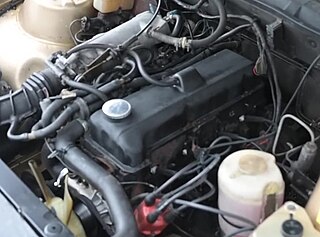
The Opel cam-in-head engine (CIH) is a family of automobile engines built by former General Motors subsidiary Opel from 1965 until 1998, appearing extensively in Opel/Vauxhall badged cars during this period. Both four- and six-cylinder inline configurations were produced. The name derives from the location of the camshaft, which was neither cam-in-block nor a true overhead camshaft. In the CIH engine the camshaft is located in the cylinder head but sits alongside the valves rather than above them, so therefore effectively is still an overhead valve design. The valves are actuated through very short tappets and rocker arms. The engine first appeared in the Opel Rekord B in 1965, and was largely replaced in four-cylinder form by the GM Family II unit as Opel/Vauxhall's core mid-size engine in the 1980s, with the six-cylinder versions continuing until 1994 in the Omega A and Senator B. A large capacity 2.4L four-cylinder version continued until 1998.
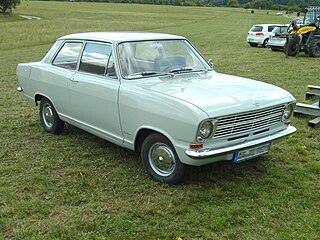
The Opel Kadett B is a car that was launched by Opel at the Frankfurt Motor Show in late summer 1965. The Kadett B was larger all-round than the Kadett A: 5% longer both overall and in terms of the wheelbase, 7% wider and 9% heavier, albeit 10 mm (0.39 in) lower in basic standard "Limousine" (sedan/saloon) form. Production ended in July 1973, with the successor model introduced a month later following the summer shut-down, in August. Unlike its predecessor, it bore no relation to the Vauxhall Viva, which had moved to its own platform for its corresponding second generation.






